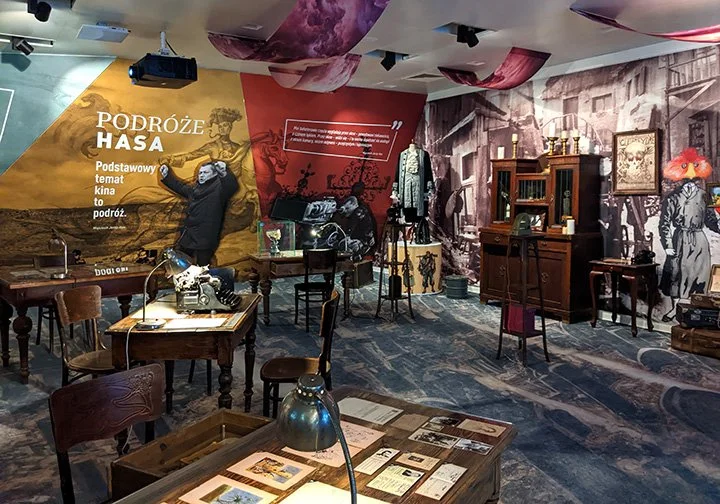Wojciech Jerzy Has: Bridging Literature and Cinema
Wojciech Jerzy Has’s films are celebrated for their deep literary roots, where literature breathes life into the cinematic canvas. This unique bond between text and image allows viewers to experience stories framed by complex human emotions and intricate visual narratives. This article uncovers the major works directed by Has that draw inspiration from literary masterpieces, each offering a distinct exploration of themes like memory, love, identity, and reality.
Key Films Inspired by Literary Works
Has’s direction vividly translates the subtleties of Polish and European literature into compelling cinema. Below is an overview of some of his most significant films and their literary origins:
| Film Title | Literary Source | Theme |
|---|---|---|
| The Noose (1957) | Short story by Marek Hłasko | Addiction and loneliness, a psychological portrait unfolding in one day |
| Farewells (1958) | Novel by Stanisław Dygat | Youth, loss of innocence, and wartime disillusionment |
| Shared Room (1959) | Novel by Zbigniew Uniłowski | Warsaw bohemia’s dreams and struggles during the 1930s |
| Goodbye to the Past (1960) | Short story by Stanisław Dygat | End of love and the fleeting nature of memories |
| Gold (1962) | Short story by Józef Hen | Post-war treasure hunting; a moral tale about greed and redemption |
| How to Be Loved (1963) | Short story by Kazimierz Brandys | Memory, guilt, and solitude from wartime survivor’s perspective |
| The Manuscript Found in Saragossa (1964) | Novel by Jan Potocki | A baroque labyrinth blending reality with fantasy, visually dazzling |
| The Doll (1968) | Novel by Bolesław Prus | Man torn between love and reason, ideal and reality, with rich visualization |
| The Hourglass Sanatorium (1973) | Stories by Bruno Schulz | Dreamlike exploration of time, memory, and death, rendered poetically |
| Memoirs of a Sinner (1985) | Inspired by Jerzy Harasymowicz’s prose | Introspection, guilt, and dream-reality interplay |
Original Screenplays and Philosophical Inspirations
Not all of Has’s work derives strictly from literature. Some films like From Nowhere to Nowhere (1975) embody original screenplays infused with philosophical reflections influenced by literary greats such as Fyodor Dostoevsky and Bruno Schulz. These works challenge viewers to ponder the human search for meaning in an often absurd world. Similarly, The Tribulations of Balthazar Kober (1988), Has’s final film, offers a visually arresting parable on the quest for truth, blending mystical imagery and spiritual themes.
Experiencing the Films of Wojciech Jerzy Has Today
For visitors or cinephiles interested in exploring Wojciech Jerzy Has’s extraordinary union of literature and film, festivals such as the Austin Polish Film Festival provide an ideal platform. Audiences gain not only the chance to watch Has’s acclaimed film The Manuscript Found in Saragossa but also to engage with a documentary on the director’s life and work alongside curated exhibitions of film posters and memorabilia.
Why Has’s Literary-Inspired Cinema Matters for Cultural Tourism
Films like those directed by Has hold a unique place at the crossroads of art, literature, and culture, offering meaningful narratives that immerse viewers in the historical and emotional landscapes of Poland and Europe. Exploring his filmography opens doors to understanding the rich intellectual heritage behind the images, a perfect complement to a cultural travel itinerary that appreciates storytelling in all its forms.
Hechos destacados y experiencia personal
While analysis and critiques can illuminate the depth behind Wojciech Jerzy Has’s films, nothing quite compares to experiencing them firsthand. Platforms like GetExperience.com empower film lovers and travelers alike to seek out tailored excursions and cultural tours that bring these stories and their settings to life. Through verified providers, the site ensures safe and flexible payment options, along with personalized offers that wholly cater to your particular tastes and travel plans.
Whether it’s an adventurous dive into Polish cinema or a thoughtful excursion tracing the literary footprints of masterful storytelling, choosing such a resource helps avoid unnecessary detours and lets you focus on making the most out of every cultural discovery. Consigue las mejores ofertas GetExperience.com.
Conclusion: A Cinematic Blend of Literature and Visual Poetry
Wojciech Jerzy Has’s films stand as timeless examples of cinematic artistry deeply rooted in literary tradition. From poignant psychological dramas to complex, multi-layered narrative labyrinths, his work invites audiences on journeys both familiar and fantastical. This rich tapestry of adaptation and original creativity enhances travel experiences related to cultural discovery and film appreciation alike. Whether you seek to immerse yourself in museum tours featuring cinematic history or participate in interactive cultural workshops inspired by these themes, such experiences open new dimensions of understanding.
Ultimately, Has’s fusion of texts and images offers a compelling invitation to explore adventure activities, interactive cultural workshops, and other travel experiences that bring stories vividly alive through the magic of both words and film.

 A Journey Through the Literary Inspirations in Wojciech Jerzy Has’s Films">
A Journey Through the Literary Inspirations in Wojciech Jerzy Has’s Films">